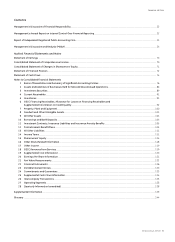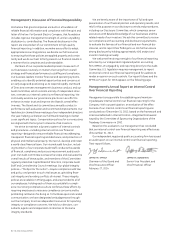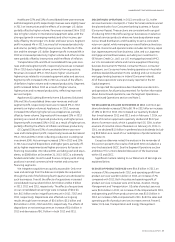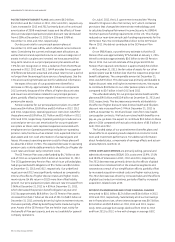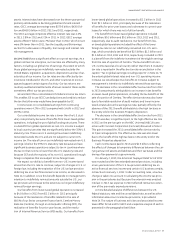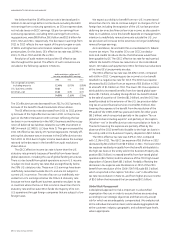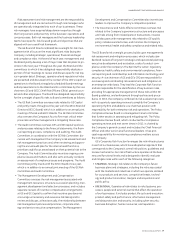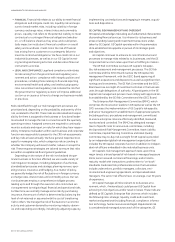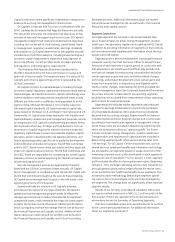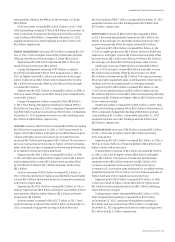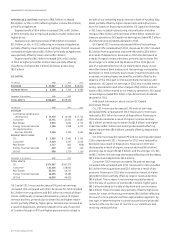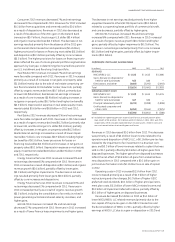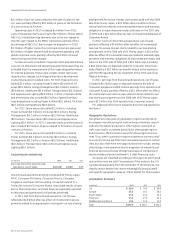GE 2013 Annual Report Download - page 39
Download and view the complete annual report
Please find page 39 of the 2013 GE annual report below. You can navigate through the pages in the report by either clicking on the pages listed below, or by using the keyword search tool below to find specific information within the annual report.’
GE 2013 ANNUAL REPORT 37
assets. Interest rates have decreased over the three-year period
primarily attributable to declining global benchmark interest
rates. GECC average borrowings were $379.5 billion, $420.0 bil-
lion and $450.5 billion in 2013, 2012 and 2011, respectively.
The GECC average composite effective interest rate was 2.4%
in 2013, 2.8% in 2012 and 3.1% in 2011. In 2013, GECC average
assets of $522.7 billion were 7% lower than in 2012, which in turn
were 5% lower than in 2011. See the Liquidity and Borrowings
section for a discussion of liquidity, borrowings and interest rate
risk management.
INCOME TAXES have a signifi cant effect on our net earnings. As a
global commercial enterprise, our tax rates are affected by many
factors, including our global mix of earnings, the extent to which
those global earnings are indefi nitely reinvested outside the
United States, legislation, acquisitions, dispositions and tax char-
acteristics of our income. Our tax rates are also affected by tax
incentives introduced in the U.S. and other countries to encour-
age and support certain types of activity. Our tax returns are
routinely audited and settlements of issues raised in these audits
sometimes affect our tax provisions.
GE and GECC fi le a consolidated U.S. federal income tax return.
This enables GE to use GECC tax deductions and credits to reduce
the tax that otherwise would have been payable by GE.
Income taxes on consolidated earnings from continuing
operations were 4.2% in 2013 compared with 14.6% in 2012 and
28.5% in 2011.
Our consolidated income tax rate is lower than the U.S. stat-
utory rate primarily because of benefi ts from lower-taxed global
operations, including the use of global funding structures. There
is a benefi t from global operations as non-U.S. income is subject
to local country tax rates that are signifi cantly below the 35% U.S.
statutory rate. These non-U.S. earnings have been indefi nitely
reinvested outside the U.S. and are not subject to current U.S.
income tax. The rate of tax on our indefi nitely reinvested non-U.S.
earnings is below the 35% U.S. statutory rate because we have
signifi cant business operations subject to tax in countries where
the tax on that income is lower than the U.S. statutory rate and
because GE funds the majority of its non-U.S. operations through
foreign companies that are subject to low foreign taxes.
We expect our ability to benefi t from non-U.S. income taxed
at less than the U.S. rate to continue, subject to changes in U.S. or
foreign law, including the expiration of the U.S. tax law provision
deferring tax on active fi nancial services income, as discussed in
Note 14. In addition, since this benefi t depends on management’s
intention to indefi nitely reinvest amounts outside the U.S., our
tax provision will increase to the extent we no longer indefi nitely
reinvest foreign earnings.
Our benefi ts from lower-taxed global operations increased
to $4.0 billion in 2013 from $2.2 billion in 2012 principally
because of the realization of benefi ts related to the sale of
68.5% of our Swiss consumer fi nance bank, Cembra Money
Bank AG (Cembra), through an initial public offering (IPO), the
realization of benefi ts for prior-year losses, and the resolu-
tion of Internal Revenue Service (IRS) audits. Our benefi ts from
lower-taxed global operations increased to $2.2 billion in 2012
from $2.1 billion in 2011, principally because of the realization
of benefi ts for prior-year losses and a decrease in current-year
losses for which there was not a full tax benefi t.
The benefi t from lower-taxed global operations included
$0.4 billion, $0.1 billion and $0.1 billion in 2013, 2012 and 2011,
respectively, due to audit resolutions. Our benefi t from low-
er-taxed global operations included the effect of the lower
foreign tax rate on our indefi nitely reinvested non-U.S. earn-
ings, which provided a tax benefi t of $2.5 billion, $1.3 billion and
$1.5 billion in 2013, 2012 and 2011, respectively. Included in 2013
is a benefi t from the indefi nite investment of the eligible earnings
from the sale of a portion of Cembra. The tax benefi t from non-
U.S. income taxed at a local country rather than the U.S. statutory
tax rate is reported in the effective tax rate reconciliation in the
caption “Tax on global earnings including exports” in Note 14. To
the extent global interest rates and non-U.S. operating income
increase, we would expect tax benefi ts to increase, subject to
management’s intention to indefi nitely reinvest those earnings.
The decrease in the consolidated effective tax rate from 2012
to 2013 was primarily attributable to an increase in tax benefi ts
on lower-taxed global operations, including the tax benefi t on the
sale of a portion of Cembra. The effective tax rate was also lower
due to favorable resolution of audit matters and lower income
taxed at rates above the average tax rate, partially offset by the
absence of the 2012 benefi t attributable to the high tax basis in
the entity sold in the Business Property disposition.
The decrease in the consolidated effective tax rate from 2011
to 2012 was due, in signifi cant part, to the high effective tax rate
in 2011 on the pre-tax gain on the NBC Universal (NBCU) trans-
action with Comcast Corporation (Comcast) discussed in Note 2.
This gain increased the 2011 consolidated effective tax rate by
12.9 percentage points. The effective tax rate was also lower
due to the benefi t of the high tax basis in the entity sold in the
Business Properties disposition.
Cash income taxes paid in 2013 were $2.5 billion, refl ecting
the effects of changes to temporary differences between the car-
rying amount of assets and liabilities and their tax bases and the
timing of tax payments to governments.
On January 2, 2013, the American Taxpayer Relief Act of 2012
was enacted and the law extended several provisions, including
a two-year extension of the U.S. tax provision deferring tax on
active fi nancial services income and certain U.S. business credits,
retroactive to January 1, 2012. Under accounting rules, a tax law
change is taken into account in calculating the income tax provi-
sion in the period enacted. Because the extension was enacted
into law in 2013, tax expense in 2013 refl ected retroactive exten-
sion of the previously expired provisions.
A more detailed analysis of differences between the U.S.
federal statutory rate and the consolidated rate, as well as other
information about our income tax provisions, is provided in
Note 14. The nature of business activities and associated income
taxes differ for GE and for GECC and a separate analysis of each is
presented in the paragraphs that follow.






